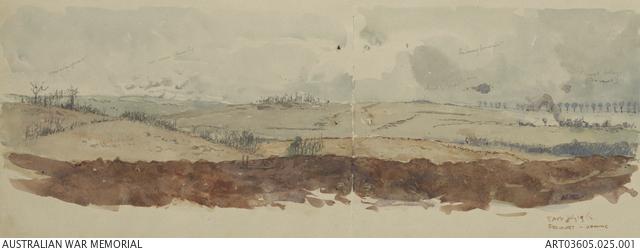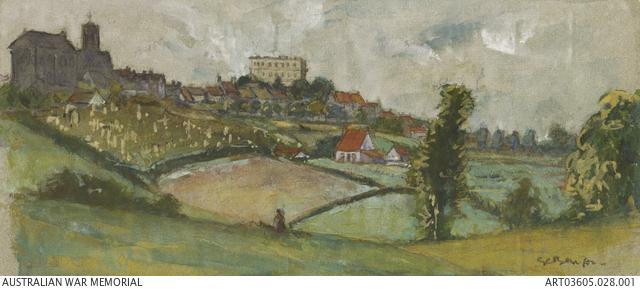George Courtney Benson: an assiduous artist
Studio portrait of Lieutenant (Lt) George Courtney Benson in military uniform.
George Courtney Benson (1886–1960) was among the first Australians to leave for service abroad. After enlisting in September 1914, he served with the 3rd Field Artillery Brigade in Egypt and Gallipoli, and the British Expeditionary Forces in France, before taking up a commission as an artist with the Australian War Records Section (AWRS) in May 1918. Having worked on poster design and illustrations for magazines during peace time, Benson diligently recorded sketches throughout his wartime service. According to S.W. Gullett, officer in charge of the AWRS in France, Benson was “a good artist, easy to handle”, and “worked hard”.
During the Gallipoli campaign Benson’s skills in draughtsmanship were highly valued. Prior to the landing on 25 April 1915, Benson made panoramic sketches from the deck of HMS Queen Elizabeth, documenting Turkish trenches and strategic features of the terrain. On the peninsula Benson often drew panoramic sketches while under fire, plotting enemy positions in the landscape. In recognition of his actions he received a special mention in divisional orders of acts of conspicuous gallantry.


Benson’s painting Anzac looking south (1919) is based on a reconnaissance sketch which the artist drew for the 1st Division sometime between May and August 1915, meticulously locating key sites, including Pope’s Hill, Deadman’s Ridge, Quinn’s Post, Johnston’s Jolly, Courtney’s Post, Achi Baba, and Gaba Tepe. This drawing and the subsequent corresponding painting provide audiences today with an informative portrayal of the peninsula as it was known to Australian soldiers during the war.

Benson continued to produce panoramic drawings during his service on the Western Front. One example is his reconnaissance sketch of Fricourt in the Somme region, drawn at 5am on 19 July 1916. Benson has focussed on the visual details of the scene, documenting the colours and sights such as wire entanglements, shells bursting, the outline of trees, woods in the distance, and the ruins of Fricourt.

In comparison, Benson’s sketch from an observation post near Ecoust on 12 April 1917 is a schematic, broad panorama documenting the location of several villages. He inscribed the drawing in the lower right corner, “Sketch from O.P.-C.3.C.3.1”. This sketch was acquired by the Australian War Memorial in 1921, when the significance of the work’s inscription would have been immediately understood. A century later, however, its meaning is not readily apparent.
The letters and numbers provide trench map coordinates. Understanding this nomenclature would have been second-nature to Benson and his fellow soldiers. Benson abbreviated the map reference and did not include the sheet identifier. Online access to historical maps greatly simplifies mapping of First World War field sketches, and we are particularly indebted to McMaster University for their digital archive of trench maps from the war. Matching the towns shown in Benson’s sketch to maps digitised by McMaster University led me to Sheet [Bapaume] 57c. NW. I narrowed my search to the 6,000 yard square C, then the 1,000 yard square 3, followed by the 500 yard quarter sub-section square “c”. This square is further divided into 10 on both the horizontal and vertical axis, and the final element in the map reference “3.1” provides the east and north coordinates. Counting three tenth across from left to right along the lower border of square “c” and one tenth up gave the precise location of Benson’s sketch. Thanks to Benson’s diligence in accurately recording the drawing’s place of creation, it is possible for later audiences to compare “then and now” images of the site on which Benson stood and rendered his sketch a century ago.

Benson’s diligence meant he was often self-critical and demanding of himself. This is evident in an inscription he wrote to accompany a watercolour drawing he created in 1916 of the Army Headquarters in Cassel.
“Cassel - Army Head Qrs. in the large building in the centre - in peace time a Casino. The church is Notre Dame de la Crypt. Cassel was a delightfully picturesque old town - tho doubts may be cast on that statement when looking at the accompanying work of art.”
Benson was a fascinating artist to research for Art of nation. His field sketches contain meticulous detail that is made even more remarkable considering the sometimes dangerous circumstances under which they were created. His work offers great insight into the landscapes experienced and depicted by Australian soldiers in the First World War.
